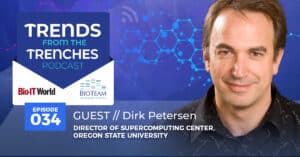Automatic Characterization of Retina OCT Images
To help our client with their Optical Coherence Tomography (OCT) image characterization needs, BioTeam worked with their researchers to develop an OCT segmentation software to automate the processing and segmentation of porcine retinal OCT images. BioTeam used machine learning (ML) techniques that have previously been shown to successfully segment human retinal OCT images using many types of biomarkers [1].
Since there were no publicly available trained ML models for porcine retina layers from OCT images, BioTeam developed the OCT segmentation software using supervised deep learning methods to automatically segment healthy and degraded porcine retina layers in OCT scans. One of the key goals of the segmentation software was the ease of use for researchers so they could easily deploy it to process and analyze new OCT images obtained from their experiments.
Initial results have shown that the retinal OCT segmentation software provides an effective evaluative tool for researchers using porcine models for retinal degeneration. The trained U-Net and DeepLabv3+ networks yielded an overall macro dice coefficient of 0.94 and 0.84 when tested on the healthy and degraded retinas evaluation data sets, respectively.
Researchers studying eye-related diseases frequently collect large numbers of retinal OCT images from patient and animal studies. Accurate and quantifiable characterization of retina layers in OCT images is important to differentiate healthy from diseased eyes since abnormal retina layers correlate to common disease types. For example, Age-Related Macular Degeneration (AMD)—the leading cause of blindness worldwide—can be diagnosed by identifying abnormal retinal layers caused by fluid build-up in the eye. Furthermore, different stages of AMD can be characterized by identifying the area and amount of degradation across retinal layers as a biomarker.
A common practice for researchers is to capture OCT images and manually delineate the different retina layers to assess retinal health. However, this task, commonly referred to as manual retina layer segmentation, is a time-consuming and inefficient process at scale that often only leads to a qualitative analysis of retina OCT images. This has created the need for an efficient and quantitative method for characterizing retina layers to differentiate healthy from diseased eyes in the clinic accurately. The ability to characterize each of the retinal layers at a pixel level would allow clinicians to use OCT images to characterize a disease state when compared to a baseline test of a healthy eye.
Future Work and Model Improvements
This first successful iteration of ML-driven OCT segmentation software model development has opened the door for future development work to enhance the software’s capabilities further. Examples include:
- Retraining the underlying ML models with larger datasets. Performance may improve with larger ground truth datasets and preprocessing techniques such as image augmentation.
- Training additional ML models to allow identification of other retinal pathologies.
Lessons Learned
- Developing successful ML models in biomedicine requires deep expertise in life sciences itself and technical expertise in machine learning, mathematics, statistical analysis, and software engineering.
- There is a tremendous desire to use ML by life science researchers. ML implementation skills are lagging behind that desire. As we conduct our ML work, we often find that a lack of familiarity with ML model architectures and implementation challenges researchers in the life sciences to develop effective ML models.
- ML and software engineers may not understand the biological implications of that work or what it may take to draw meaningful scientific conclusions. To succeed, the engineers need to understand the biologist, and the biologists need to understand the engineers.
- It is challenging to manage data for ML projects in biomedicine. It is important to standardize the format of data, as well as track its history and model versions in a traceable way using MLOps tools.
- It is important to keep in mind the end user’s technical expertise and prioritize ML model usability. For example, many researchers do not know how to use console-based applications. It is important to develop a graphical user interface (GUI) that is intuitive to the researchers using the model.
- Researchers need to be careful as these models have limitations in terms of generalizability. Results can vary depending on modifications to variables such as the disease state, the hardware configuration to obtain images, or the physical conditions under which the images are taken.


